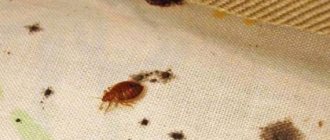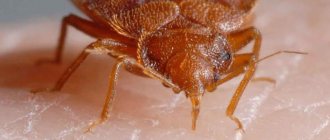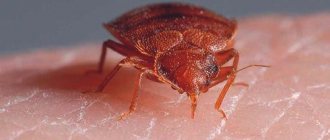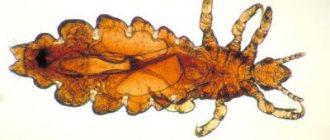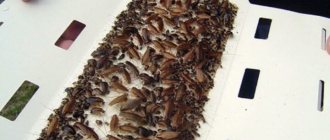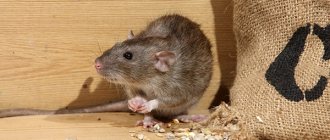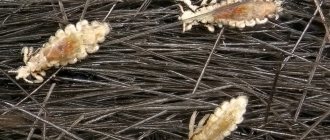Are bedbugs afraid of light?
It is believed that bedbugs are repelled by light. Indeed, if you wake up at night and turn on the lamp, insects try to hide behind something. This is why people think that leaving a light on all night will stop them from biting. They leave the lamp on for 1, 2, 3 days - no new bites appear. But then the bugs crawl out of their hiding places and attack with renewed vigor.
Constantly switched on light changes the habitual way of life of parasites. They are used to being active in the dark, so they wait for its onset for several days. All this time they remain hungry. When hunger becomes too severe, they have to leave their shelters to avoid dying. The result is complete adaptation of insects to light. Therefore, it is effective against them only for a short time.
Removing bedbugs using an ultraviolet lamp
Ultraviolet and quartz lamps are used in medicine to disinfect premises. They emit ultraviolet light in the frequency range that is capable of resolving the DNA of microorganisms. Such radiation is also harmful to humans. It causes dry skin and leads to premature aging. High-intensity light can cause retinal burns.
If ultraviolet radiation is harmful even to humans, are bedbugs afraid of ultraviolet lamps? Yes, their eyes are very sensitive to light, which can blind them. But vision is secondary for parasites. They spend most of their time in the dark and navigate only by smell. Therefore, briefly turning on an ultraviolet or quartz lamp will not bring the desired effect.
In order for ultraviolet light to kill a bug, it must be exposed to light for 4–5 days. Then the light will cause dehydration and death of the insect. You can’t keep the lamp on for that long at home. A person will receive more harm from it than from the bite of a bed parasite.
Industrial products
Chlorpyrifos
Pin
Chlorine, as a toxic substance, is used by industry to produce insecticides. The most famous of them is Chlorpyrifos, which is included as a constituent element in most common insecticides.
Effectively acts on adults, nymphs and eggs of bedbugs.
In its chemically pure form it is white crystals, soluble in warm water. The product for killing domestic insects Chlorpyrifos is a white emulsion containing more than 47% of a toxic substance, a fragrance to eliminate odor and stabilizers to preserve the structure of the substance.
Due to high toxicity and effects on fetal development in pregnant women, it has been banned in the United States since 2000.
The product is used by professional pest controllers and in agriculture for preventive pest control. Treatment of premises is carried out by spraying the product onto contaminated surfaces and in areas of colonies. Requires the use of personal protective equipment when working.
Advantages of the product compared to other insecticides of similar action:
- medium intensity odor;
- high efficiency in destroying bedbugs;
- relative resistance to decay, delayed action period up to 180 days.
The disadvantages of Chlorpyrifos include:
- toxicity to animals and humans (third class of toxic substances);
- rapid adaptation of insects to the product.
To guarantee the destruction of bedbugs, the premises must be re-treated over the next 14 days. Surfaces that people will touch should be washed with soap and soda solution.
Chlorpyrimark
Pin
The drug Chlorpyrimark is used to kill domestic insects and is an analogue of Chlorpyrifos. Contains it as the main active ingredient in an amount of up to 50% of the composition. Externally it is a thick, straw-colored emulsion with a pungent odor. It is a means of professional disinfection due to its high level of toxicity.
The delayed action period is 45 days and has a strong toxic effect on all domestic insects and their eggs. For each type of insect, the emulsion is diluted with water to a different concentration (for bedbugs - 0.24%).
Sychlor
Pin
Chlorpyrifos is used as a component in the insecticide Sichlor, the purpose of which is to kill bedbugs and other parasitic domestic insects. The product is approved for use in apartments and residential premises and belongs to hazard class 4.
Visually, Sichlor is a drug with a pungent odor, in the form of an emulsion, the constituent substances are Cypermethrin (10%) and Chlorpyrifos (20%). Affects the nervous system of insects, paralyzing the transmission of impulses.
The delayed action period is up to 45 days, this allows you to destroy the larvae that have hatched from the eggs. For work, use a fresh solution of the required concentration (0.5 ml of Sichlor 100 g of water), which is used to spray the nests of bedbugs.
After disinfestation, surfaces that people will touch are washed with soap and soda solution (door handles, table surfaces, etc.).
Manufacturers of Sichlor guarantee the total destruction of bedbug colonies within 10 days after treatment. If the infection is severe, the premises will need to be re-treated within 10-15 days.
Do smells repel bedbugs?
Couch bloodsuckers have a developed sense of smell. They smell a person at a distance of up to 3 meters, and carbon dioxide released during breathing - at a distance of up to 30 m. Therefore, it is believed that treating the home with strong-smelling compounds helps repel bedbugs. Is it so?
Vinegar
Vinegar has a pungent odor. Therefore, it can act as a repellent, but not longer than 6 hours. It should be borne in mind that acetic acid is often diluted with water before use to obtain a solution with a weak concentration. In this form, it will not be able to spoil the furniture and decoration. But then the smell will disappear in half an hour.
To get the desired effect, you will have to treat the apartment with vinegar essence. But concentrated acid not only damages property, its fumes cause burns to the mucous membranes of the eyes and respiratory tract. Therefore, using vinegar against bedbugs is either useless or dangerous.
Tar
It is a resinous product that is obtained by dry distillation of wood. It contains resins, phenol, toluene, cresol, benzene, toluene and other substances. They have a strong odor that penetrates into materials. It is impossible to remove it later, but it can take months to disappear on its own.
Despite the strong smell, tar does not work any better than vinegar. During the first days, parasites can remain in shelters. But when hunger becomes stronger than fear, they will still crawl out and get your blood. But your apartment will smell for a long time.
Bleaching
Bleach is used to bleach fabrics and disinfect premises. It smells strongly and causes a burn upon contact with the outer shells. That's why bedbugs are afraid of her. To remove them from the apartment, you need to wash the floors and other surfaces with water and bleach. To prevent burns, you should work with gloves.
You can also use bleach to control bedbugs. It needs to be scattered in all corners, crevices, and secluded places. It will disrupt the integrity of the bug's shell and lead to the death of the parasite. The price of such a victory is the unbearable smell of chlorine, which can cause poisoning and pulmonary edema.
Attention! Bed bugs are afraid of bleach. But it cannot be used in large quantities at home, because it is no less toxic to humans than to insects.
Flammable substances
If bed bugs appear in a house, people advise treating it with gasoline, diesel fuel or kerosene. The point here is not so much the smell, but the resinous consistency of the liquid fuel. It clogs the sensilla - the respiratory organs on the surface of the bug's body, through which oxygen enters (insects do not have a nose). As a result, the parasites suffocate.
To get rid of bedbugs using gasoline, kerosene or diesel fuel, you need to thoroughly treat all surfaces and crevices in which bloodsuckers can hide. Then they will inevitably touch the fuel while leaving the shelters. The problem is that flammable vapors are highly toxic to humans. Another danger lies in creating a fire hazard - the house can burst into flames from the slightest spark.
Essential oils
It is believed that the use of essential oil is effective against bedbugs. Presumably they are afraid of essential oil:
- nettle;
- rosemary;
- chamomile;
- carnations;
- lavender;
- peppermint;
- tea tree.
Using essential oils in their pure form is dangerous for humans and is ineffective in the fight against bedbugs. In order for them to smell the smell, you need to force the ether to actively evaporate. This can be done by diluting a few drops of oil in vodka. The alcohol contained in it is highly volatile and promotes better evaporation of substances dissolved in it.
You can make your own repellent using essential oils. This is the name of the odorous product that bed bugs are afraid of. To prepare it you will need:
- 60 ml water;
- 30 ml vodka;
- 10 drops of peppermint and lemon (grapefruit) essential oil;
- 8 drops of lavender essential oil;
- 5 drops of geranium oil;
- 3 drops of rosemary, cypress and vanilla oils (can be replaced with patchouli and myrtle oils).
All components must be mixed until smooth and placed in a spray bottle. Homemade repellent should be used daily on living rooms and furniture. The advantages of this product are safety for humans and a pleasant aroma at home. The disadvantages include the low efficiency of the method. Over time, bedbugs will get used to the smell, and it will no longer repel pests.
Attention! Many essential oils are contained in the peel of citrus fruits. You can place them under the sofa, behind the bed, near cracks and other hiding places.
Plants with a pungent odor
Scented plants act like essential oils. Bed bugs do not like the pungent smell of plants such as:
- tansy;
- sagebrush;
- marigold;
- chamomile;
- calamus (root);
- mustard (seeds).
There are several ways to use herbs in the fight against bedbugs. You can lay out sprigs of tansy or wormwood on the floor, put them in a closet with linen, or tuck them into the folds of upholstered furniture. But when they dry, the aroma from them will decrease. It is difficult to pull out branches intact from secluded places - they become fragile, causing them to break and leave behind debris.
Another way to use herbs against house bugs is to prepare decoctions. For 1 liter of water you will need 20–30 g of dry grass, inflorescences, roots or seeds. They are placed in a pan and filled with water, placed on the stove. The herb and inflorescences should be boiled over low heat for 5 minutes, seeds - 10 minutes, roots - at least 20 minutes. Then the broth is cooled, filtered and used as a repellent.
Preparing a repellent based on herbal decoction takes a lot of time. But the method is not highly effective. Another disadvantage is that herbal infusions leave stains that are difficult to wash off on fabrics.
Seasonings
It is popularly believed that bedbugs do not like the smell of bay leaves, vanillin, rosemary and cloves. We have already concluded above that “aromatherapy” in the fight against bedbugs is ineffective, and it gives only temporary results. Therefore, seasonings should be used only in combination with other, more effective methods. They can be placed around the house in whole branches or sprayed with the prepared decoction.
Solvents
Acetone and turpentine also have a strong odor. However, bed bugs are afraid not of the smell of solvents, but of contact with them. They corrode the shells of insects, which leads to their rapid death. Despite the ability to exterminate parasites, the use of acetone and turpentine at home is undesirable because:
- solvents are toxic to humans;
- they dissolve paintwork;
- spoil fabrics and other materials;
- They leave behind a persistent unpleasant odor that does not disappear for a long time.
Tar or laundry soap
You can try to repel bedbugs with a soapy smell. Laundry or tar soap are more suitable for this purpose. They leave lingering odors even after drying. For humans they are harmless and quite tolerable. Another advantage of the method is that the soap film that envelops the bug interferes with its breathing. This can lead to the death of insects. But in order to treat parasites with a soap solution, you will first have to find their nesting sites.
Medicines
Among the medicines used in the fight against bedbugs, ammonia and Vietnamese balm “Zvezdochka” are used. Ammonia quickly dissipates, but the balm not only has a persistent odor, but also irritates the body of the bug upon contact. After all, it represents a high concentration of essential oils. But for processing at home you will need as much balm as you will not find in any pharmacy.
A solution of boric acid is also sometimes used in fighting. It doesn't actually harm bedbugs. They are not afraid even of its smell. The product is mistakenly used against bed bugs because it is effective against cockroaches. But the latter die from ingesting acid, while bedbugs feed only on blood.
How to fight bedbugs with bleach?
The effect of bleach on insects is limited to its repellent odor; it does not have the ability to destroy insects. To clean rooms from bedbugs, it is necessary to treat the places where insect nests are located.
To do this, it is best to use an aqueous solution of bleach, which is much more convenient to use than powdered bleach. The result of the treatment will be a decrease in the activity of bloodsuckers.
Preparing a bleach solution is quite simple - mix bleach powder with water at a ratio of 1:10. To do this, take 10 liters of water per kilogram of powder. The solution is prepared as follows:
- dilute dry bleach in a small amount of water in an enamel container (bucket);
- stir the solution with a wooden stick or spatula;
- add water to the solution to a volume of 10 liters;
- carefully close the bucket with a lid and leave for 24 hours;
- the clarified liquid is carefully poured into a dark glass bottle or other tightly closed container.
The prepared solution is used for treatment by spraying in places where insects accumulate.
On the effectiveness of electronic repellers
In recent years, electronic repellers against all pests have gained wide popularity. They are really effective against rodents, moles, birds and even mosquitoes. But in the case of bedbugs, the devices are useless. Bed bloodsuckers are not afraid of ultrasound, electromagnetic or other radiation, because they do not have sensory organs capable of perceiving it.
SES - reliable destruction of bedbugs
What do bedbugs fear most? - you ask. Professional treatment poses the greatest danger to bedbugs. Already at the very beginning, insects begin to flee en masse from the room.
The bedbug pest control service quickly determines the number of bedbugs and their habitats in the house. After this, specialists select the optimal method for their destruction and begin processing.
Thanks to modern equipment and high-quality products, disinfestation is effective and at the same time fast. Insecticides penetrate into the most inaccessible places and not only repel bloodsuckers, but also kill adults and eggs. Therefore, the number of parasites is reduced to almost zero.
If the room is heavily contaminated, re-treatment should be carried out. That is why it is best to order apartment disinfection from specialists and not wonder what bedbugs are afraid of. Any folk remedies and chemicals will only repel parasites temporarily, while SES will destroy them forever.
Is it possible to drive away bedbugs by starving them?
Bedbugs need food 2 to 7 times a week. Therefore, some people think that leaving home for 1–2 weeks is enough for the insects to die of starvation. This raises the question: are bedbugs afraid of the lack of a nearby food source?
If the search for food is unsuccessful, the insects fall into torpor. They can live in this state for several months. If, having “awakened” they do not get blood again, death is assured. But how many families are willing to leave home for many months?
Alcohol
When learning about what bed bugs are afraid of, it is worth knowing that alcohol is one of the irritating substances that negatively affects not only bed bugs, but also other insects in the home. There are many alcohol-based insect repellents available. However, they must be used carefully so as not to cause irritation or burns to the skin.
You can also use ammonia or ethyl alcohol to treat at home. The substance must be mixed with water and wipe with the solution all surfaces and places where bloodsuckers can hide. After such treatment, the apartment needs to be ventilated.
Are bedbugs afraid of pesticides?
Yes, bed bugs are very afraid of pesticides. But they do not cause fear in them, so they do not have repellent properties. However, upon contact with the insect's body, drugs called insecticides lead to their destruction. Here are the means that can be used to treat residential premises:
- aerosols (Dichlorvos, Combat);
- suspensions (Xulate Micro, Get Total);
- liquid chemistry (Executioner, Karbafos).
The advantage of using insecticides is the high efficiency of treatment. But it must be carried out twice with an interval of 10 days in order to destroy the larvae that have hatched from the eggs by this time, but have not yet reached puberty. Another disadvantage of the chemical is that over time, bedbugs develop resistance to it. Its development can be eliminated only by major treatment of premises, which is carried out by specialized organizations using the hot fog method.
Attention! Insecticides are toxic to humans and animals. Therefore, after using them, you need to leave the apartment with your pets for several hours.
Positive and negative
The positive side is that cockroaches are really afraid of the strong chlorine smell. And they do not develop resistance to this substance. This is probably where the positive ends.
And there are many negative factors. The main ones are low efficiency and harmful effects on human health. Treatment with chlorine helps to clean the home for a maximum of two days, and the process itself will take a lot of time and effort. To prevent the return of insects, it is necessary to repeat the treatment with chlorine, and this will already affect health: the vapors of the substance irritate the respiratory tract and cause coughing. The mucous membrane of the eyes also suffers: with prolonged exposure, lacrimation begins, the whites of the eyes turn red.
Finally, a chlorine solution is absolutely ineffective if you need to remove cockroaches from a large private house, especially if there are two or more floors. The owners simply won’t have time to process everything, and the cockroaches will slowly move from one room to another. Thus, bleach is not suitable for radical control.
Are bedbugs afraid of high and low temperatures?
Bedbugs need a stable temperature. When it drops to +9 oC, they stop reproducing, and when it drops to negative temperatures, the parasites fall into torpor. Therefore, there is no need to freeze in an unheated apartment in winter - the bloodsuckers will wait until the warmth returns. But you can destroy them with high temperatures. Depending on its size, the death of insects can occur instantly or after some time (see table).
| Temperature | Time from treatment to death of the bug | How to reach this temperature |
| +110 оС | Instantly. | Using a hair dryer. |
| +80 оС | Up to 7 seconds. | Using a steam generator. |
| +60 оС | Up to 10 minutes. | By washing things in a washing machine. |
At home, you can treat cracks and other secluded places with a clothing steamer. If it is missing, replace the device with an iron. As a last resort, use a hair dryer turned on at maximum power. However, hot air is less efficient than steam. Therefore, you need to treat furniture more carefully with a hairdryer.
Attention! SES employees treat the premises with hot fog, which is a concentrated solution of insecticides. It also ensures instant death of bed bugs.
How to use Dichlorvos for bedbugs
Before treating the room, pets and children must be removed from it. Remove pet accessories, close the aquarium with its inhabitants, protect dishes, food, personal hygiene products and textiles.
The first step is to shake the can of the product and direct the stream of product to the area where the pests were noticed
It is important to keep the canister away from you so that the fumes do not get into your face. They need to treat walls, baseboards, cabinets, corners, furniture, window sills, the area around the sink and trash can.
Be sure to spray the product on the back of carpets, paintings, loose wallpaper, on the legs and backs of furniture, especially those that are located close to the walls.
Leave the premises immediately after treatment. After 10 minutes, start airing the room.
You should return to the premises no earlier than after one hour. Expectant mothers, children, allergy sufferers, people weakened after illness and pets can be allowed into the treated room after 4 hours. But the best option for everyone is to wait 24 hours. After airing the room, it is necessary to carry out a thorough wet cleaning using an aqueous solution with soap and soda.
What exactly are bedbugs afraid of?
Here are the means and methods that will definitely harm bedbugs:
- boiling water;
- hot fog;
- use of insecticides.
To combat bedbugs, diatomite is also used - this is a rock consisting of the shells of diatoms. It is ground into powder, the particles of which have abrasive properties. When they land on the bedbug’s body, the waxy coating of the carapace is damaged. The damage increases the evaporation of moisture, which leads to the death of the parasite from dehydration.
ECOKILLER - what is it and how to use it correctly
ECOKILLER is a natural insecticide based on diatomite. It is sold in bottles with a long and narrow dispenser tube. With its help, you can pour the powder into all places where bedbugs can hide: behind the baseboard, sofa, bed mattress and small crevices. After a day, the house needs to be wet cleaned. If parasites are detected, the procedure is repeated.
How does Ecokiller work?
Here are the advantages of ECOKILLER:
- The product has no odor.
- Diatomite is not addictive to insects.
- The powder is safe for humans and animals. It is often used to produce dietary supplements and vitamin-mineral complexes.
- The product is used sparingly. For processing an apartment of 50 square meters. one bottle of 500 ml is enough. You can order it here.
The fight against bedbugs requires urgent measures. Parasites can be removed using different methods. But those products that harm bedbugs are also dangerous for humans. Therefore, they cannot be used in a home with children. In this case, it is better to use an alternative and no less effective method, which is to treat the home with diatomaceous earth powder. After contact with it, bedbugs will die within 7–9 days.
Order a safe bedbug repellent
Efficiency of bleach
To understand whether bleach kills bedbugs, you should know the mechanism of action of the substance. Contact of an insect with the powder causes severe burns, often incompatible with the life of the bloodsucker. But in order to kill a bug in this way, it must be generously sprinkled with chlorine.
Considering the harm bleach has on the human body, it is not possible to scatter the substance over the entire area of the apartment. Small piles of chlorine will not stop the insect, since the bug, sensing a specific smell, will bypass the chlorine mounds.
Bleaching
Comparing the possible harm from using the drug and its short-term repellent effect, the answer to the question of whether bleach helps against bedbugs can only be negative and it is not capable of helping in the fight against bloodsuckers.
What infections do bedbugs carry?
There is a popular belief that bloodsuckers can infect humans with AIDS, HIV, hepatitis and other deadly diseases. But this is not an entirely correct point of view. If bedbugs are found to be carriers of what diseases or parasites? Scientists had to find causative agents of typhus and relapsing fever, plague, hepatitis B, Q fever, leprosy, syphilis and tuberculosis in the bodies of bedbugs. But experts were unable to prove that the bug is capable of transmitting infections to humans.
And even more: experiments have shown that bloodsuckers are capable of accumulating retroviruses (for example, HIV) in the body, but the causative agent of the most dangerous disease for humans comes out with the bug’s feces, without multiplying in its digestive tract and without being transmitted to the victims of the parasite.
The impressive number of insects worsens the sanitary and epidemiological situation in the home. Therefore, cheap hotels, refugee camps, homeless shelters and military field hospitals pose a potential threat of infection with dangerous infectious diseases.
For a long time, it was believed that bedbugs are carriers of dangerous diseases, since the body and excrement of parasites can contain a lot of different pathogenic bacteria and infections:
- tularemia;
- relapsing and typhus;
- tuberculosis;
- yellow fever;
- leprosy;
- syphilis;
- Hepatitis B;
- HIV, etc.
However, despite the terrible list of diseases that are allegedly transmitted by bedbugs, it is unlikely that you should be completely afraid of infection. Bed bugs were not noticed as the root cause of such diagnoses, although they are “carriers”. For example, they are unlikely to “give” HIV to their victim, since parasites are able to digest this virus and excrete it in their droppings.
It is theoretically possible to become infected with other diseases by scratching a wound and introducing bedbug excrement into it, but the likelihood of this is negligible. Another route of infection is inhalation, when inhaling air in a room abundantly “inhabited” with the parasite is more likely, but such cases are also recorded very rarely.
Probably, nature has improved them so much during the existence of bedbugs that the transfer of diseases is possible only in extremely rare cases. Insects seem to have learned to “block” the penetration of infections into the human body - the source of their nutrition, which should be healthy even for parasites such as bedbugs.
According to studies conducted by scientists, the pest does not transmit HIV infection. Viral diseases do not remain stable when mixed with the mucous environment. When ingested by an insect, the virus is destroyed and cannot further reproduce in the internal environment. However, if we assume that the virus remains active inside the pest, then it is almost impossible to become infected with HIV through its saliva.
The physiological structure of the insect is such that it has two proboscis.
- When pierced, the first proboscis injects saliva, which has an analgesic effect. The new saliva has no communication with the HIV-infected blood that is inside it.
- With its second proboscis, the pest pierces the surface of the skin and sucks human blood. When blood is absorbed, there is no exchange with blood that has already entered with HIV infection, and therefore they do not cause harm.
Sunlight and daylight
Are bedbugs afraid of light? Definitely yes. These are parasites that are nocturnal. This is typical behavior for many insects that have adapted to life near humans. They bite at night, in the dark. If you turn on the light suddenly, they immediately scatter to their nests (by the way, this is how you can find out the location of the main nests). Lighting at night can help, but not for long. Bedbugs are afraid of light, but in a hopeless situation they quickly adapt and begin to attack in the light, according to their biorhythms - from 3 to 7 am for the middle zone.
Popular Bedbug bites: differences in photos, first aid, symptoms and treatment
However, providing a constant bright light source may encourage bedbugs to migrate, or at least reduce their numbers. To do this, you need to use fluorescent lamps or just bright enough light bulbs.
Why is it impossible to scare bedbugs out of an apartment?
There are several reasons for the fundamental impossibility of driving bedbugs out of an apartment. The first of them: bedbugs have nowhere to go. They do not know that they can leave this room to join their neighbors, because most of them do not move such distances in their entire lives.
There are times when they can crawl along the heating riser every night from the apartment above to you, and crawl back there the next morning. However, this is rare, and most bedbugs only know the route from their daytime hiding place to and from their bed. If something appears in the apartment that they are afraid of, they will prefer to simply endure it in shelters, and then, when they are very hungry, they will crawl out, despite the unpleasant smell for them.
Sometimes people get the false impression that if bedbugs are poisoned by neighbors, then the insects are afraid of the product and run to neighboring apartments. In fact, when baited with chemical insecticides, bedbugs do not run anywhere. They can crawl out of their shelters, they can die in these shelters, but, in fact, they cannot escape from the room.
Indeed, migration occurs when people systematically open up bedbug hiding places. Insects try to hide in new dark secluded places, people open them up too, insects crawl into new shelters and some of them end up in cracks in the walls, in sockets and electrical wiring grooves, in ventilation, and these are passages into neighbors’ apartments. Of these, this part of the bedbugs gets into the neighbors.
But such a situation is possible when neighbors either very carefully open up all the nests of bedbugs, which rarely happens (more often people are lazy and don’t do this), or when neighbors make repairs and strip all the walls, floors, and ceilings down to concrete, that is, they simply deprive bedbugs of shelter . Bedbugs, accordingly, can only hide in the paths that lead to your home, and along these paths they enter your apartment. It looks like they are "running" out of fear, but in reality they are just doing what they have been doing all along - hiding in the safest places.
If bedbugs still have places to hide specifically in your apartment, you won’t be able to drive these parasites away with any repellents. If they are afraid of something, they will simply hide in these places. This will not make things any easier for homeowners.
The second reason: bedbugs quickly adapt to many repellents, even if they were initially afraid of such drugs. This is very clearly seen in practice: if you place a wormwood branch under an uninfected bed, then for a day or two the parasites will not climb onto this bed. But then, one or two at a time, they will begin to get out from behind the baseboards, go around this wormwood and climb onto the bed, and when each individual repeats this two or three times, it will stop paying attention to this remedy. This will already happen for the third reason: hunger is stronger than fear.
This rule works throughout the animal world, and in humans too. For a day or two, while the bugs are not hungry, they may not bite if they are afraid of some kind of remedy. When they are really hungry, they will be able to overcome their fear in order to find food.
It is well known that very hungry bedbugs can get out and bite even in the light, although in general they are more afraid of light than most other environmental factors. And if they can bite in the light, then they will also bite if they smell bleach, tansy or some kind of essential oil.
And the fourth reason: not all products that are considered to repel bedbugs actually repel them. There are clear dummies, for example, ultrasonic or electromagnetic repellers. There are products that bedbugs are afraid of, but to which they get used. There are tools whose operating principles people do not fully understand.
For example, the same vinegar: if it gets on a bug, it kills it. But if you simply sprinkle furniture and walls with vinegar, the smell will repel bedbugs for two to three days. After this, the parasites will get used to it and will calmly run around the baseboards that smell of vinegar. Moreover, the smell of vinegar will weaken over time.
Hence we conclude: bedbugs cannot be driven out of the apartment by any means. Even if they are afraid of certain smells, or, for example, light, then for a short time you can reduce the strength and frequency of their bites, but after a few days everything will return to its place.
Now let's go specifically through the most well-known means, phenomena and environmental factors that bedbugs are supposedly afraid of.
How long do house bugs live?
The average lifespan of a bed bug is 10-12 months. In particularly extreme conditions (for example, during a sharp cold snap or the absence of a person in the house for a long time), they fall into suspended animation, in which they can remain for more than a year until the return of a source of food or normalization of external climatic conditions.
Lifestyle
Bed bugs are predominantly nocturnal. Only a certain danger or alarm can force them to become active during the daytime, for example, destruction of their habitat or the action of third-party chemicals.
The parasites are most active between 3 am and 6 am. At this time, they are especially dangerous for humans, since they go out in search of food, this is their feature. Insects are mobile and fast, they can get from any corner of the apartment to the bed in a matter of seconds, spend about half an hour feeding and return to their previous shelter.
Bed bugs spend most of their life cycle preferring to hide in various shelters, emerging at night to satisfy their hunger or to find a new home if the old one has been destroyed.
After a single feeding, bedbugs digest the blood somewhere in a secluded corner of the home.
Reproduction and development
Bed bugs mate through traumatic insemination:
- The male, using his genital organ, pierces the female’s abdomen and injects seminal fluid into it.
- After a few weeks, the female begins to lay eggs (up to 5 eggs daily). Over the entire life cycle, one adult female is capable of laying about 250-500 eggs.
- An insect in an egg will develop to the adult stage on average 30-45 days, but in extreme conditions development can take up to 100 days.
- Bedbug larvae immediately begin to look for food on their own, because to move to the next stage of development (and to molt) they need a certain amount of blood they drink.
